Did you know that according to the statistics 89 percent of U.S. consumers expect companies to have an online self-service support portal? So, if you want to satisfy the expectations of your audience you have to think ahead and develop the platform right now.
Moreover, the web portals encompass multiple settings for their derivatives like job portals, B2B portals, learning portals, E-Commerce portals, etc. Let’s take a detailed overview of what a web portal is, its type, pros and cons, and circumstances when you need a platform for your business.
Table of Contents
What is a web portal?
A web portal is an online platform that keeps data from different resources into a single user interface and presents customers with the most actual information for their context. It may include links to categorized information, such as articles, products, vendors, suppliers, individuals, etc. Moreover, it often includes a membership component where users log in and have access to their own profiles.
The main differences between websites and web portals
People often mixed up websites and web portals, as both look rather similar, but used for absolutely different tasks. Let’s overview their critical differences.
| Criteria | Website | Web portal |
| Definition | A web-based solution that consists of web pages containing publicly available content. | A web-based solution that contains personalized content, available for authorized users. |
| Access | Accessible via URL | Accessible via URL plus a login (username and password) |
| Users | The broad audience, no restrictions | A specific group of authorized individuals |
| Content | Can be changed only by the admin | Can be changed by authorized users who have relevant permissions |
| Purposes | Create a digital presence for a business, drive traffic | Create a single point of access to information for authorized users |
Both websites and web portals have their own advantages and based on your business’s requirements you can choose any of them.
How can this benefit your business?
A good web portal can make the user experience better, grow sales, and streamline content distribution. Let’s take a look at the advantages that creating a platform gives to the company.
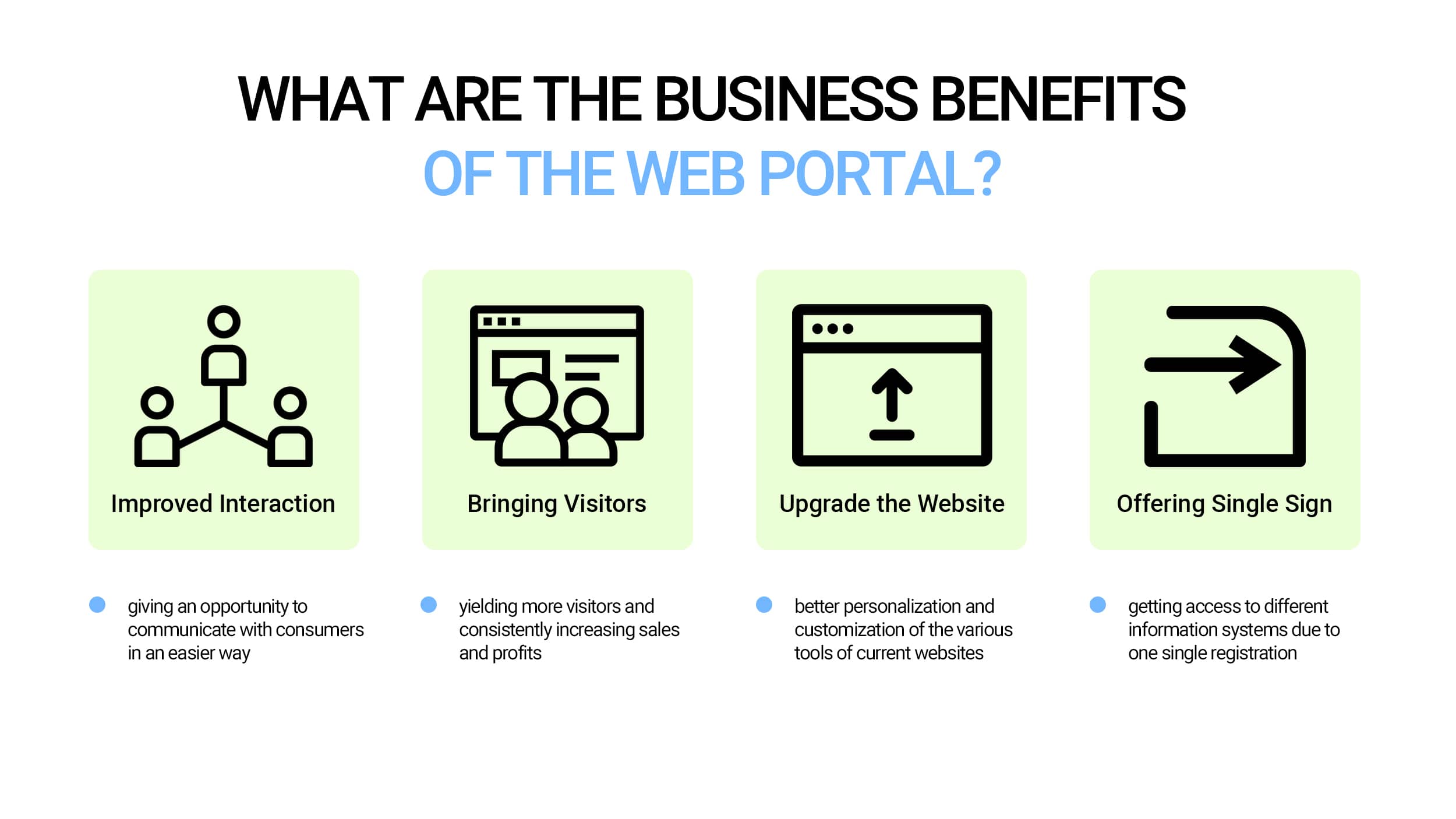
Platforms give an opportunity to communicate with consumers in an easier way, reply to their numerous questions, and so on.
☑️Bringing Visitors
A well-made company web portal brings more visitors and consequently boosts the sales level.
☑️Upgrade the Current Website
Moreover, often web portals are needed for better personalization and customization of the various tools of current websites.
☑️Offering Single Sign for a Variety of Applications
Web portals give an opportunity to get access to different information systems due to one single registration.
Summing up, a good web portal can be useful for companies in different ways. The most crucial facts are that it is able to improve a business’s Internet presence and rebrand it.
Types of web portals
There are two common types of web portals: horizontal and vertical.
✓Horizontal web portals
Usually, horizontal web platforms are intended for several companies using. It’s like a portal that contains the information required by the users. Good examples are learning, governmental, news portals.
✓Vertical web portals
This kind of web portal is used by organizations to share with customers some unique information. Examples of such portals are tender, college, and auction bidding ones.
Now let’s discuss more specific web portals that are oriented on various particular purposes and have a different target audience.
Specific types of web portals
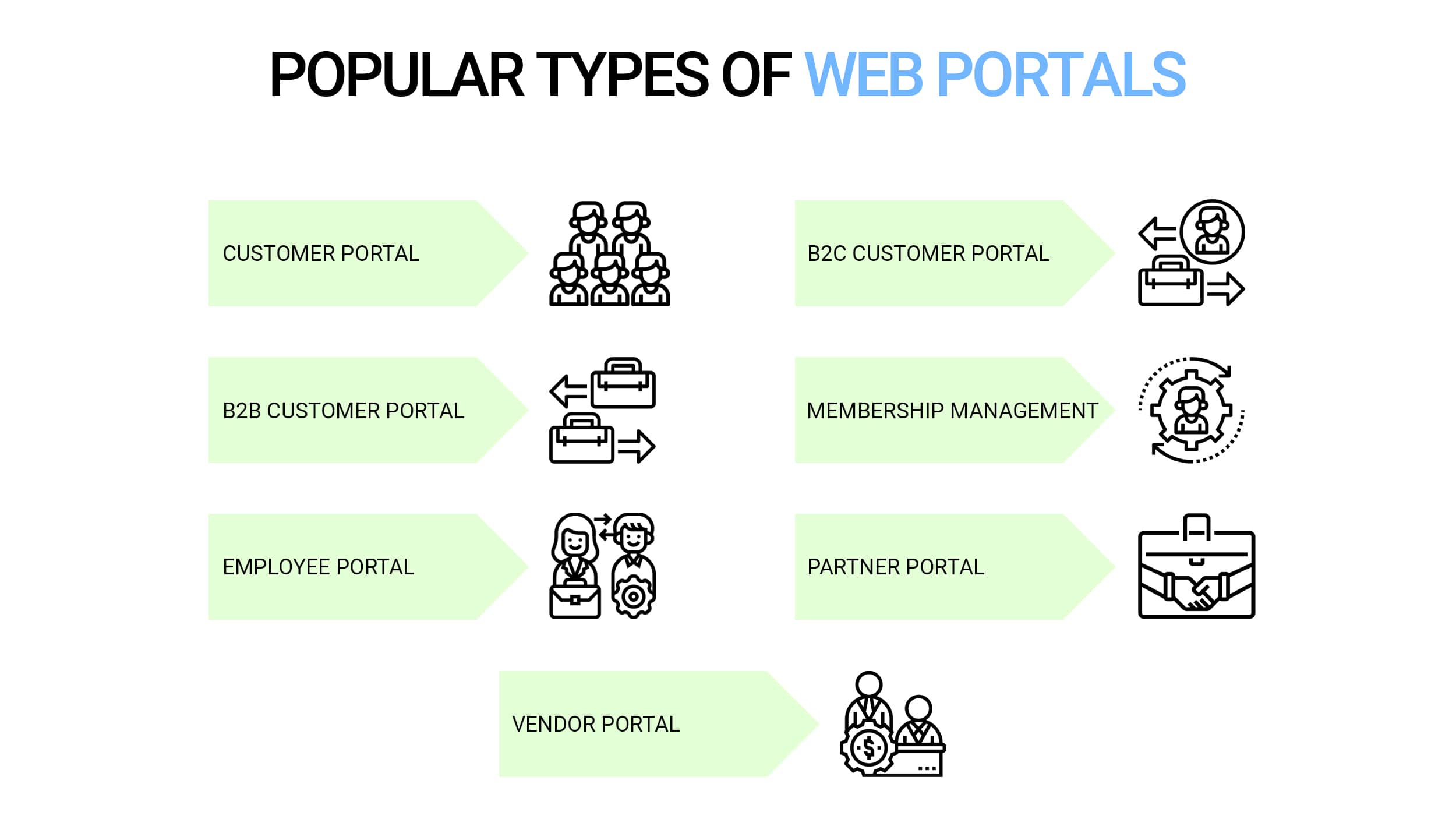
The customer portal is a good variant if you want not only to take customer support and sales process to the next level but receive a chance to make people more loyal to the brand. Consumers have an opportunity to place and track orders themselves, activate or deactivate services, get personalized recommendations, review the purchase history, and do many other things without any contact with your staff.
✓B2C customer portal
B2C customer portals make the user experience better and also help companies establish long-lasting and loyal partnerships with their consumers. There are several key features that the B2C portal should have: private account creation and editing, intuitive order placement, features for checking and managing orders.
✓B2B customer portal
B2B customer portals are needed to provide excellent customer service. So, it has to satisfy vendors’ requests, optimize online sales, and save the company’s cost.
✓Membership management portal
Membership management web portals are a good idea for all types of companies that offer membership subscriptions. The most widespread of them are through different learning platforms. They make the user experience better. So, people as members are able to get all materials, build training or any other plans for using a service, monitor the progress, payments, etc.
✓Employee portal
The employee portal is the first step for organizations that go online. It looks like the inner social network where users can communicate, assign tasks, leave comments, log timesheets, request vacations, etc. Moreover, it helps newcomers to overcome onboarding chaos and become a part of the team without stress.
✓Partner portal
In 2020 companies are not isolated, they need to cooperate with lots of other businesses to solve different tasks. The web portal is a good way to provide an ongoing process of information exchange, two-way communication, and constant involvement of all parties engaged.
✓Vendor portal
Vendor web portals are a perfect tool for organizations that need a platform for communication with suppliers. They make processes easier and more efficient since all the information is kept in one place.
As you can see, platforms are a good idea for different niches and for different goals. It makes them so popular and demanded.
How to create an online portal
A well-quality web portal looks like a pool with cool water in the hot summer. To get out of there on your own, you need to have the willpower of the level of Chuck Norris, no less! And in order to become the proud owner of such a resource, instead of trying to get a free template with limited functionality, it is better to choose web portal development by professionals.
Functionality
The features you include in your web portal can make or break the project. The comfortable platform needs to have these functions:
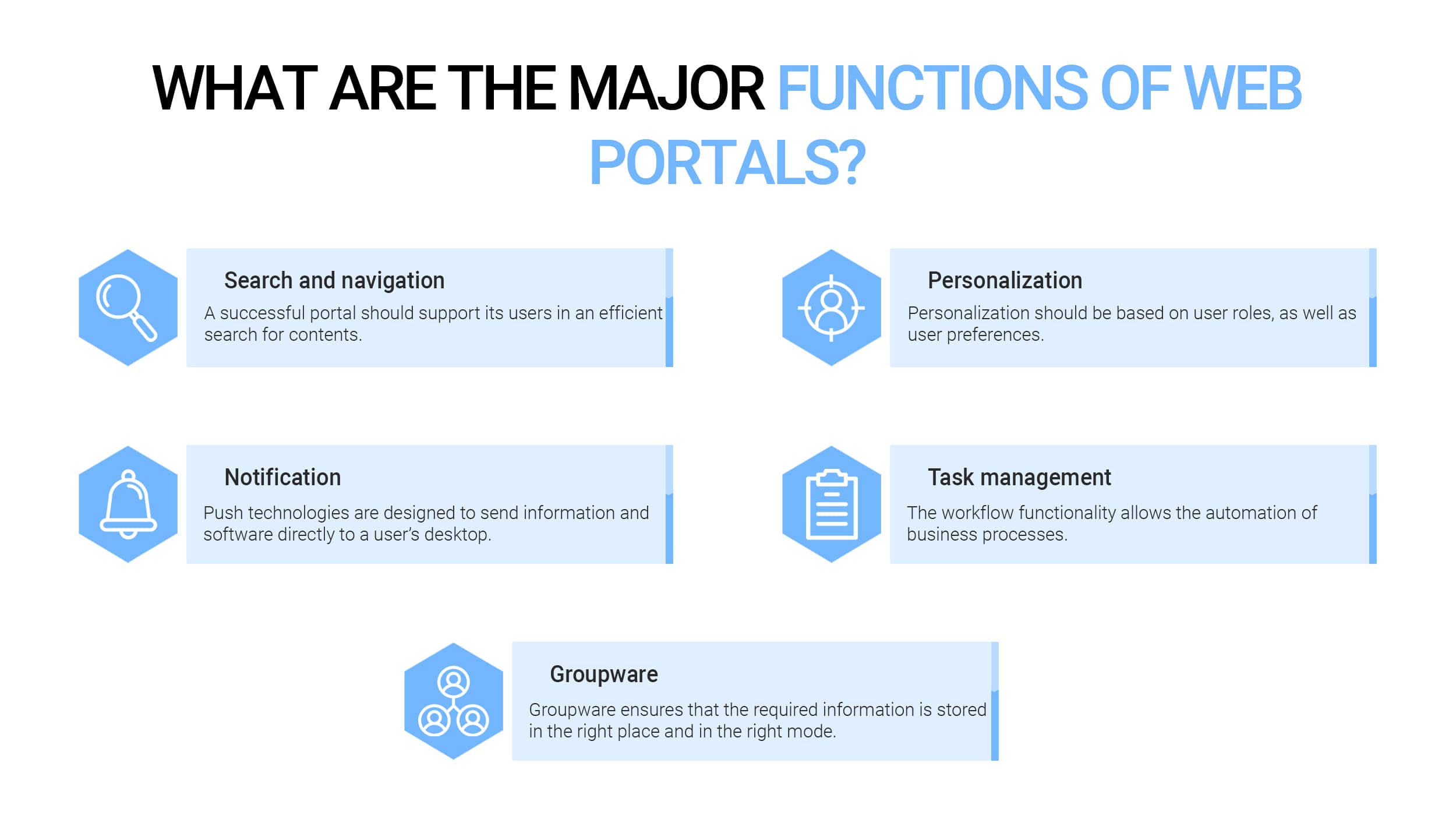
- search and navigation;
- personalization;
- notification;
- task management and workflow;
- collaboration and groupware.
Thus, an outstanding web platform does not only include good collaboration support and a nice integration of the information sources. Rather it consists of a well-integrated mixture of the basic portal functionalities.
Common Issues
Web portals have plenty of advantages. But there are some problems that you can encounter.
- Enterprises Lack of a Governance Model
Have you got a responsible team for updating and ensuring the content of the web portal? The success or failure of a platform is often dependent on who takes control. Sometimes, it becomes a problem as different parts of the intranet are assigned to different departments.
- Portals are Outdated and Lack Easy to Use Functionality
If information is outdated, there is a high probability that employees will provide inaccurate information to the clients, advisors will not be able to get access to important tools, etc. All these lacks make the user experience poor.
- Company Underestimate the Cost and Complexity Involved in Creating a New Portal
Are the right people involved in the project? Do they have enough time and resources? Did they make research? It’s impossible to get a good result without all those things.
- Organizations Plan a New Portal Without Considering the End-User
One more widespread mistake is creating a web portal without understanding the end-user needs.
- Lack of Training
Ok, the web portal is ready but advisors don’t hurry up to use it. Usually, it means that there was no proper education and training plan for staff.
All the listed problems are very common. So, you need to try your best to avoid them.
Progressive web application development: Cost, Tech Stack, Advantages
Web portal development steps
Let’s overview the main web portal development steps, and why they are needed.
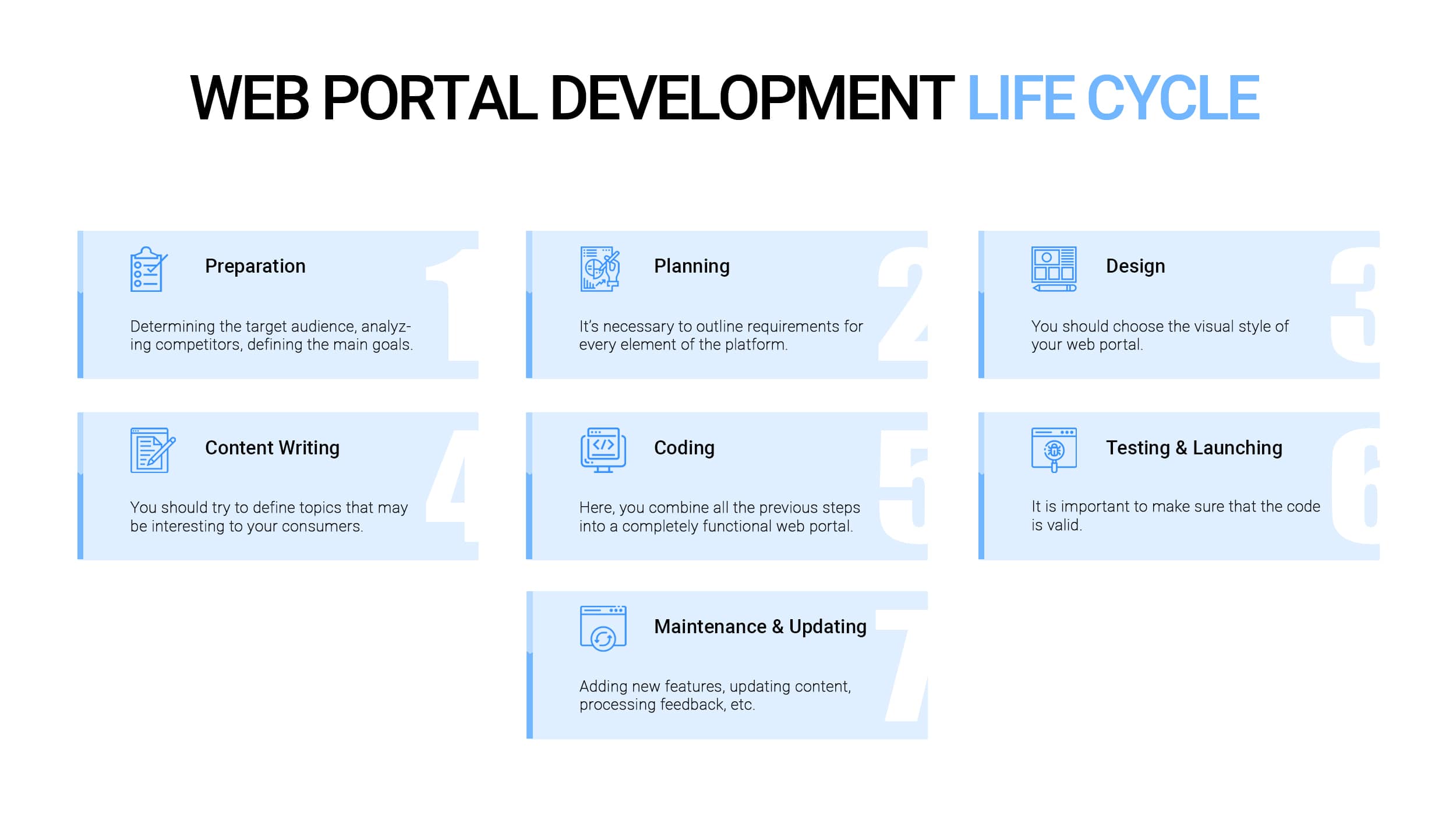
The preparation stage is the most crucial one. A good preparation won’t require you to spend your money on solving unexpected issues.
This stage includes determining the target audience, analyzing competitors, and defining the main goals. At this stage, it’s important to set the time scope and specify web development roles and responsibilities properly.
2. Planning
This stage includes a development schedule considering all tasks and setting the deadlines. Also, it’s necessary to outline the requirements for every element of the platform.
3. Design
The first step is to build the architecture of the platform. It can be made by creating a sitemap. Next is to choose the visual style depending on the topic and the potential consumers. I.e., the company web portal has to look strict while news ones can look like you want.
4. Content Writing
Good content is a key to success. You should try to define topics that may be interesting to your consumers than take care of its optimization. What people can search and what queries can lead them to the platform? Think about it. People need just a moment to understand if the page is useful. So, use this time to make them interested.
5. Coding
It’s a stage when your ideas come true. Usually, the process of website development starts with the home page then moves on to follow the web portal structure.
6. Testing & Launching
To underestimate testing is a bad idea. Everything may look fine, but some bugs can be unnoticed at the first sight. So, at this stage, it is important to make sure that the code is valid, and the user experience is seamless. When all the bugs are fixed, the platform is ready to be available on the Internet. It’s time to upload it on the server and check everything again.
7. Maintenance & Updating
Launching is not the end. To remain the platform outstanding and visited, you have to always update it. As soon as it becomes available for users lots of new tasks appear. I.e, adding new features, updating content, processing feedback, etc.
As you can see, creating a web portal is not a simple task. But following these steps makes the process more efficient and transparent.
Technology stack for custom web portal development
The tech stack you choose for your web portal development depends on your requirements. There are two main options: using CMS, or developing from scratch on the framework.
CMS is a good variant for city or news web portal with little or medium traffic. WordPress is the most widespread CMS worldwide. It was originally designed for blogging. So, if your product is designed to publish a large number of articles, it’s a perfect option. But there are some disadvantages. I.e., it will be difficult to implement a personal account or full-fledged chat. Moreover, this CMS is not suitable for high traffic.
If you need a web portal with very complex functionality, developing from scratch on the framework is the only right way. You will get an advanced solution with flexible settings. Usually, for this task, we use such PHP-frameworks as Yii2 and Laravel and such e-commerce platforms as Magento and Shopware.
Web portal development cost
Web portal development cost depends on the type, features, and difficulty of the work. If you want to hire dedicated web developers, the custom development will cost from $20 000 to $80 000. It’s not a total cost. In case you need a very complex solution with many user groups having different rights and permissions.
For a better understanding of the final price and time, we have prepared a table that is relevant Minimum Viable Product (MVP) development of a web portal. So, the final price probably will be higher as well as development time.
| Features | Approx development time, hours | Approx. cost, $ |
| 1. Project Start | ||
| Initial backlog preparation | 2 | 58 |
| Project Schedule Preparation | 2 | 58 |
| Staging environment setup | 4 | 116 |
| 2. Development Section (Back-end) | ||
| Setting project API configuration (depends on the type of API) | 12 | 348 |
| DB structure implementation: – common structure; – users permissions/roles, relative dependencies |
28 | 812 |
| Registration/authorization service: – authorization middleware; – sign up; – log in |
35 | 1015 |
| 1st user role features (depends on your industry/type of portal) | 20 | 580 |
| 2nd user role features (depends on your industry/type of portal) | 49 | 1421 |
| Admin features | 60 | 1740 |
| 3. Development Section (Front-end) | ||
| Main features (depends on your industry/type of portal): | ||
| Common web application structure | 12 | 348 |
| Login/Signup page | 12 | 348 |
| Common dashboard | 36 | 1044 |
| Messages section | 28 | 812 |
| Payment screen | 20 | 580 |
| Setting screen | 10 | 290 |
| Reports creation page | 12 | 348 |
| 4. Stabilization and Delivery | ||
| Deployment | 12 | 348 |
| 5. Project management | ||
| Backlog elaboration and maintenance | 6 | 174 |
| Planning meetings, review meetings | 14 | 406 |
| Project Management and communication | 16 | 464 |
| Quality assurance: | 65 | 1885 |
| Total Development: | 354 | 10266 |
| Total Project Management: | 36 | 1044 |
| Total: | 455 | 13195 |
Web Application Development Cost: The Full Guide On Your Project Price
Our expertise
Code&Care has vast experience in the web portal development of various types and for various niches. Below are just a few cases. Let them inspire you.
ReachAd
ReachAd is a German performance-based online marketing agency. Our main goal was to create a web portal that makes custom newsletters together. Also, we supported various internal tools that helped to automate the company’s processes.
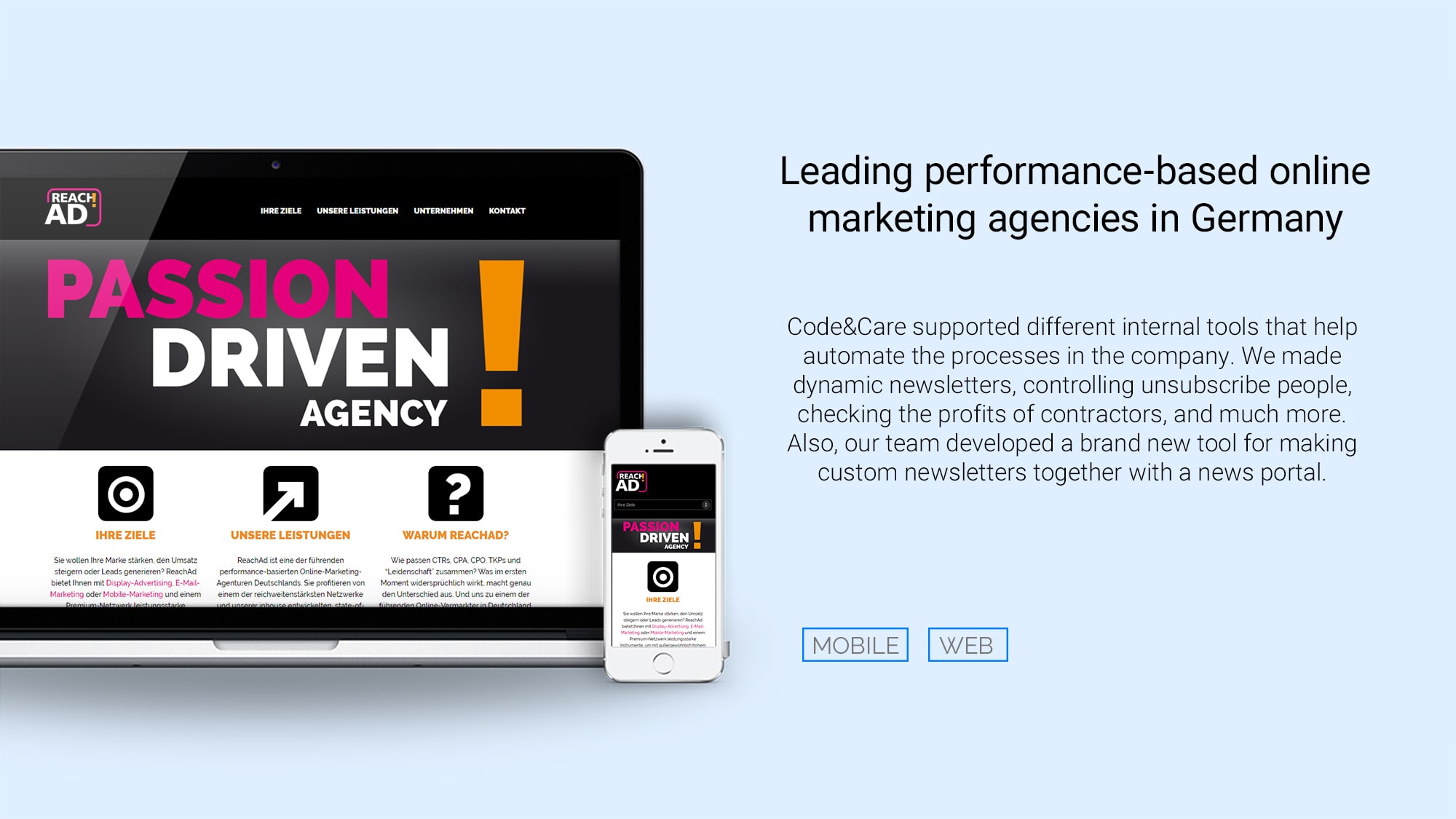
LRTT is a global social enterprise providing teacher training for tutors across 10 countries with limited resources. Code&Care developed a web portal to unite the efforts of more than 20 000 teachers’ community.
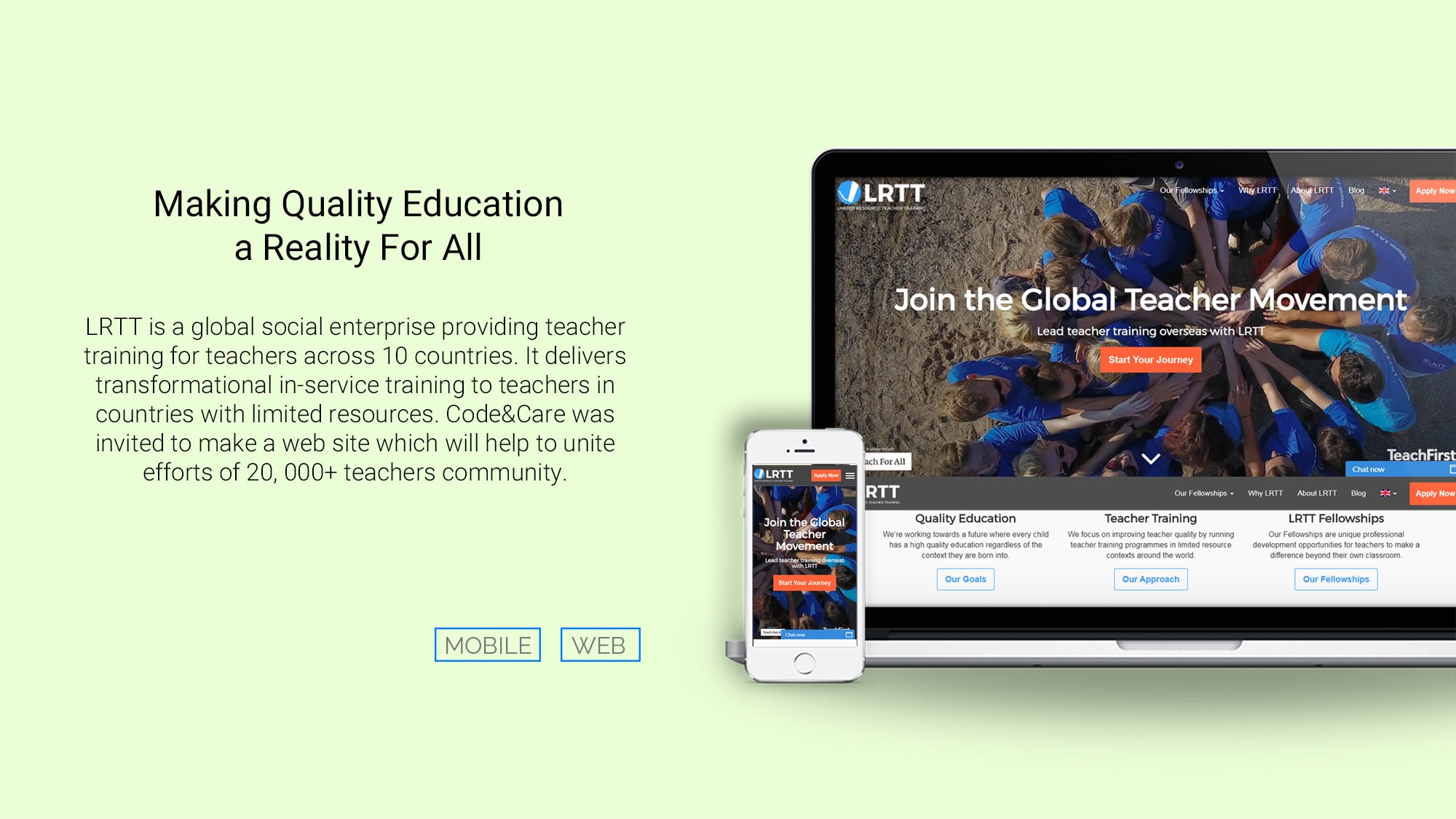
National Debt Relief is one of the biggest American debt settlement companies. Their key services are debt settlement as an alternative to bankruptcy, credit counseling, and debt consolidation. Our task was to rebuild the company’s website.
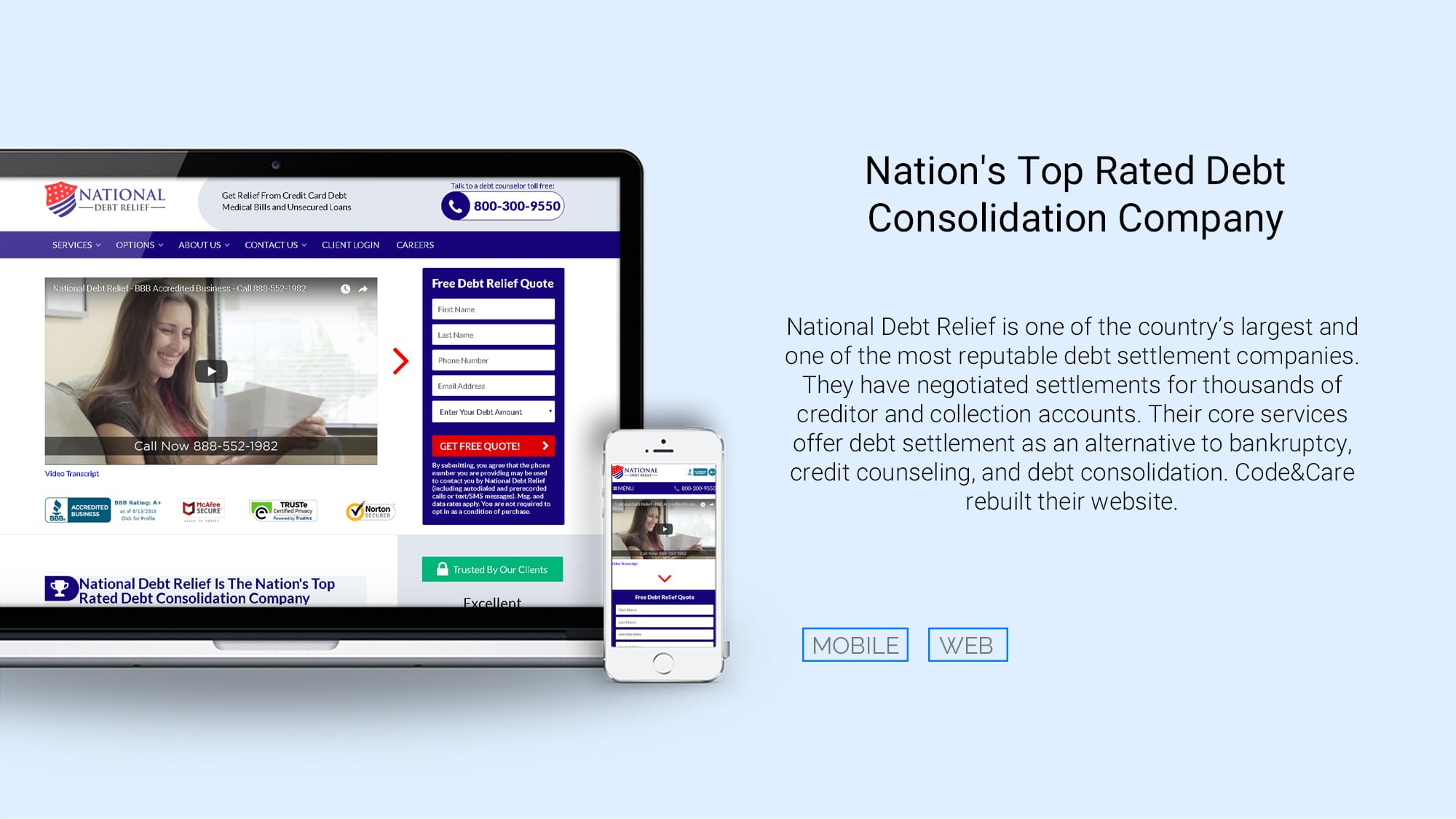
Real Connex is a growing network of real estate professionals from everywhere. Code&Care provided a dedicated team for back-end and front-end product support.
This list of services above is supposed to show you how an idea transforms into a great business when you are completely passionate about what you do. If you feel like creating an outstanding web portal with a strong and experienced team, do not hesitate to contact us and describe your business idea.

Web Development Trends 2022
How to Build a Marketplace Website
How to Build a CRM Software
How to make a location-based app

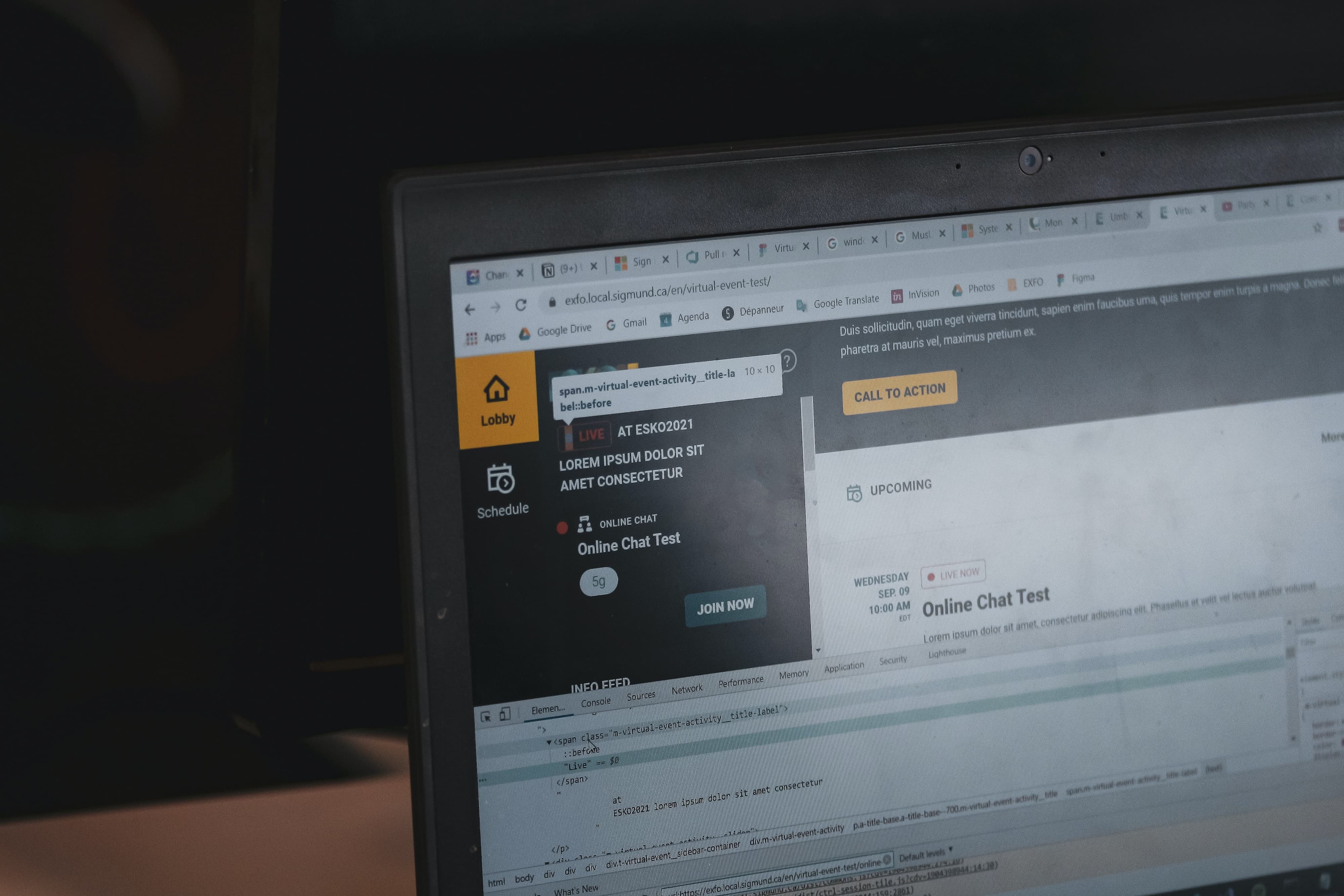














Popular
Latest